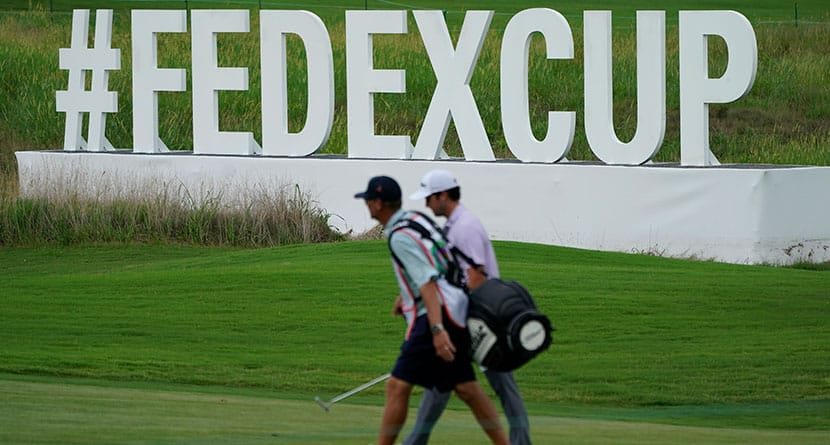OLYMPIA FIELDS, Ill. (AP) — Good news for Chicago: The golf-crazed market that once feared it would get the big names only every other year now gets two tournaments in a month.
Both events have $20 million purses. Both have small fields populated by former major champions. Only one can be found on The CW Network.
Of course, the BMW Championship that starts Thursday and LIV Golf-Chicago on Sept. 22-24 have far more differences than similarities.
Start with the venue. Olympia Fields is best known for hosting four men’s majors and one that used to be considered a major (Western Open); Rich Harvest Farms is best known for hosting the Solheim Cup and the Palmer Cup.
The most notable difference — not just the blaring music or players in shorts — is that one is played over 54 holes with the same 48 players. That’s a big reason why the Official World Golf Ranking board is still trying to determine how or even why LIV should be part of ranking.
Then again, only 50 players made it to Olympia Fields, the second and arguably the most critical of the FedEx Cup playoff events. Those 50 get in all the $20 million signature events next year on the PGA Tour, giving them an advantage over everyone else.
And only 70 players reached the postseason last week at the TPC Southwind, down from 125 players a year ago. The difficulty of making it to the FedEx Cup playoffs was obvious when it was announced last summer and highlighted even more when Justin Thomas didn’t make it.
The chatter on the range last week was whether the PGA Tour would adjust the number to 72 next year to look after Thomas. Some of those tongue-in-cheek notions were borne out of jealousy, some out of cynicism that this brand-new PGA Tour model was only about the elite looking after their own interests.
But it is something the PGA Tour should consider going forward, because if there is one risk of looking like LIV, it’s seeing the same players at every tournament. That makes it hard to develop storylines, which was the case with the last three majors held over 10 weeks.
That’s what Phil Mickelson always wanted. He said as much as early as 2005, if not sooner, arguing for fewer PGA Tour events on the schedule so the top players could compete against each other more often.
It was easier to identify the top players some 20 years ago. Now golf has seen the emergence of Wyndham Clark and the resurgence of Lucas Glover, to name a few. There will be others. That’s critical to the success of this new PGA Tour model.
Bigger fields have a greater tendency to generate better outcomes. Some of the biggest challenges Tiger Woods faced were not from Mickelson or Ernie Els. They were from Bob May and Grant Waite, even Kaname Yokoo one year on the Japan Golf Tour.
Having a small field for the $20 million events were important in the big picture. To have those events at 120 players — or even 90 — would create less reason to play elsewhere. As it stands, the other tournaments are now important as a pathway to get into the big-money events.
The signature events will have 15 extra spots that come from performances in regular tournaments, key to the concept of meritocracy. How it plays out for an entire season remains to be seen, though the PGA Tour has run some projections and is trying to get to the same turnover rate among the top 50 players, which is roughly 62%.
Turnover is key, and one example of how hard golf has become is the Tour Championship. Hideki Matsuyama has the longest streak of reaching the FedEx Cup finale — nine years, now in jeopardy since only a blazing finish last week allowed him to get to Chicago. Next in line are Jon Rahm, Tony Finau and Xander Schauffele, all of whom are set to go to East Lake for the seventh straight year.
Also worth noting is that of the 23 players in the Delaware meeting last year that began to reshape the PGA Tour model, five of them didn’t even make it to the postseason — Thomas, Billy Horschel, Shane Lowry, Kevin Kisner and Adam Scott. Two others are injured (Woods and Will Zalatoris). Another (Joaquin Niemann) went to LIV.
Some 50 other players at the BMW Championship last year were not even invited, leading to some hard feelings and a lot of mistrust about every step taken since then — from size of fields to whether there should be a cut.
The PGA Tour is supposed to be hard. It’s also always been about opportunity. So if the PGA Tour can adjust the FedEx Cup — there have been four changes dating to 2007 — it can always review the size of its playoff events.
There’s no reason more players shouldn’t at least have a chance at the first stop, and there was nothing wrong with 70 players at the BMW Championship.




